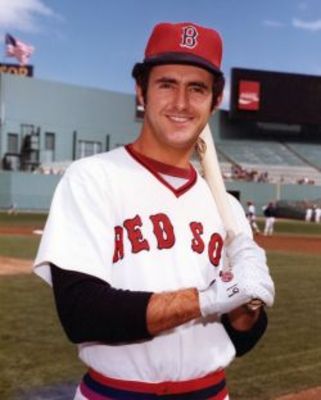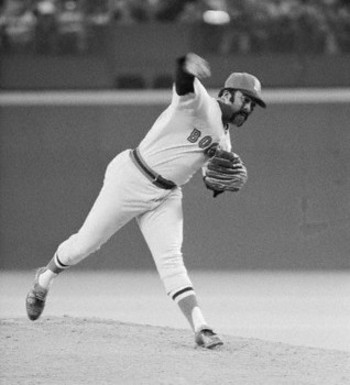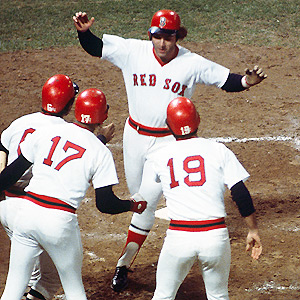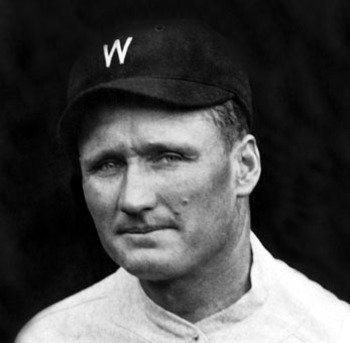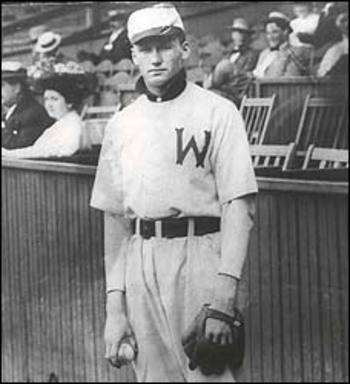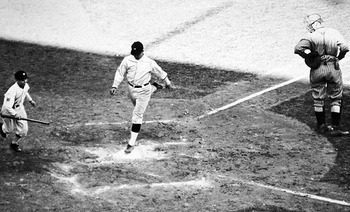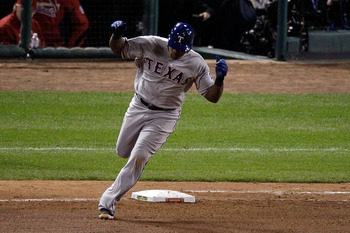Ed Armbrister pinch hit for pitcher Jack Billingham, already the Reds third pitcher of the game, and walked. Pete Rose followed with a single and suddenly, with Ken Griffey, Joe Morgan, Johnny Bench and Tony Perez due up next, the Fens buzzed with anxiety.
Fred Lynn was on the move with the crack of the bat. He had already put the Red Sox ahead 3-0 with a first inning 3 run home run and now he had a chance to break the Reds' back with another sensational catch. This was a rookie but you couldn't tell from his performance in the biggest week of the baseball season. He tracked the ball towards left-center field, that big green wall. It wasn't headed to the monster, it was that little angle where the odd dimensions of Fenway converge. Fred Lynn had only played in this park for a year but he had learned to trust his abilities and trust the other outfielders.
(Fred Lynn had an amazing rookie year in 1975. He became the first player to earn Rookie of the Year and MVP honors in the same year. Not until Mike Trout, for the 2012 Angels, would another rookie have the impact that Lynn had for the 1975 Red Sox)
(Ed Armbrister was involved in a controversial play in game 3 that led to a Reds win. He pinch hit in Game 6 and earned a walk, scoring on Ken Griffey's triple)
The ball shot off the wall and Dwight Evans was there to field it and fire it back into the infield but not before Armbrister and Rose had scored and Griffey stood on third with a triple. New England held their collective breath as Yastrzemski, Evans, manager Darrell Johnson and the team trainer stood over a body. It was a bad sign when Yaz had to help Lynn straighten out his legs which had staid in that position since he had hit the wall.
Eventually Lynn was helped up. He rolled his head around a few times, did a few bends and nodded to the trainer that he was OK. He got a quiet, reserved standing ovation from the Boston fans, but the moment had come. This was the beginning of the end, Sox fans were sure. Just like every other disappointing year since 1918.
The Reds were able to tie the score in that inning but that was it. The Sox weren't losing, but still, there was a sense of doom hanging over Boston as the city waited for the other shoe to drop. It came in the top of the 7th. Luis Tiant was the heartwarming story of the series. His career had been resurrected in Boston after some tough years in Cleveland and Minnesota. He now had a chance to become the first pitcher to win three games in one World Series since Denny McLain for the Tigers in 1968 and had a chance to do it in front of his parents. After leaving Cuba to become a Major League pitcher over ten years ago, he had not seen his parents, who still lived in Cuba. That was until a deal was made with Castro to allow the senior Tiants to visit the US to see their son perform in the World Series. He had not disappointed but the tired arm could hold out only so long.
He had breezed through the first 4 innings. Gave up three in the fifth after Lynn's crashing attempt but had settled down in the 6th. The Reds batters didn't like his pace. It was too quick. So they started to slow the game down themselves. Calling time late. Stepping out of the box late. Taking time in between pitches. Making Tiant work. He gave up two runs in the 7th but got out of further trouble then gave up a lead off home run to Cesar Geronimo to start the 8th.
(Luis Tiant used a deceptive pitching motion to keep batters off balance. Leading up to the series the Reds argued through the press that Tiant's motion was a balk. In Game 1 he was called for a balk. Tiant nearly became the first pitcher since 1968 to win three World Series games.)
Lynn started the 8th with a single to leftfield and Rico Petrocelli worked a walk. Runners on 1st and 2nd. 0 out. Any momentum that was being built was quickly quieted as Evans struck out swinging and Rick Burleson flew out to leftfield. That brought up the pitchers spot. Darrell Johnson went to his bench for a pinch hitter. Bernie Carbo walked to the plate. He had hit a pinch hit home run in Game 2 and Johnson hoped he might be able to do it again.
Eastwick's 2-2 pitch was low and inside. Carbo couldn't decide what to do: take it or swing. Too close to take and now too late to get a good swing. The ball was nearly in Bench's glove when Carbo finally decided he better do something, so he awkwardly dropped the bat head in the direction of the pitch and fouled the ball off. Tom Adelman, in his great book The Long Ball: The Summer of '75- Spaceman, Catfish, Charlie Hustle and Greatest World Series Ever Played (honestly one of the greatest books I have ever read), would call this the ugliest swing in the history of baseball, and it is hard to argue. Red Sox fans had essentially thrown in the towel. The next 2-2 pitch came in and Carbo swung again.
Dick Stockton had called every Red Sox game that year and watched the ball off the bat. "Deep centerfield! Way back, way back! We're tied up!"
Fenway erupted as the wake ended and the crowd awoke. Carbo clapped his hands as he rounded second, knowing he would be a Red Sox legend for life.
(Bernie Carbo was originally drafted by the Reds. When Reds manager Sparky Anderson cut him several years later Carbo was bitter. Carbo hit two pinch hit home runs in the 1975 World Series tying Chuck Essegian (1959 Dodgers) for most pinch hit home runs in one series)
It would be hard to say that the Big Red Machine could ever be desperate with a future hall of fame manager, three future hall of fame players (two or three others that should be in the hall of fame and one more who would be in the hall of fame if not for his own poor life choices). This team would not give up and the big bats would be coming up. Morgan, Bench, Perez. If anyone would scare the Red Sox relievers, these guys would. If anyone was scared on the Red Sox they didn't show it. Morgan, Bench and Perez went down quickly raising the pressure on the Red Sox.
(The 1975 Big Red Machine lineup: Catcher Johnny Bench (5), First Baseman Tony Perez (14), Second Baseman Joe Morgan (5), Shortstop Dave Concepcion (13), Third Baseman Pete Rose (14), Outfielder Ken Griffey (30), Outfielder Cesar Geronimo (20) and Outfielder George Foster (15). The team won the World Series in 1975 and 1976.)
Baseball fans immediately recognize the situation. Bottom 9th. Tie Game. Runner on third. Less than 2 outs. A fly ball wins the game. The Reds had few choices with Fisk, Lynn and Petrocelli due up next. Sparky Anderson paced the dugout trying to decide what to do. He finally held out his hand with four fingers extended and Fisk was walked to load the bases. Facing Lynn was certainly no less dangerous than facing Fisk but at least it set up a force play at any base that might save the day.
Lynn just needed a fly ball to get the run in from third. He got it, but as soon as it was hit he could tell it wasn't deep enough. Foster ran to the foul line and lined up the catch. Fenway's odd dimensions came into play again. The foul line along leftfield runs very close to the wall and gives a right handed outfielder throwing home a hard time to get good arm extension on a throw.
Before the pitch Don Zimmer, coaching third base, had yelled in Doyle's ear: "Anything in the air you tag up immediately. Wait for me to tell you if you're going." Doyle stood on third watching Foster come in to make the catch. Zimmer knew right away it wasn't deep enough so he was surprised when he turned and saw Doyle heading toward home.
"NO, NO, NO!" Zimmer yelled to Doyle. Doyle later said he heard Zimmer yelling "Go, Go, Go!"
Foster made the catch at the wall, took one step back and fired a perfect strike to Bench at home. Doyle's out, double play and the momentum back to the Reds. Petrocelli grounded out to end the inning and the stadium fell silent again. This game was getting better as it went along. Pinch hit home runs, plays at the plate, extra innings. If the fans there only knew what they were about to see they would have laughed at how excited they were getting over these small things.
(Denny Doyle took off from third on George Foster's catch in the bottom of the ninth. Bench waited with the tag.)
The game moved to the 10th. The Reds got a one out single and a steal of second by Dave Concepcion but they stranded him there. Momentum to Red Sox. Boston sent Evans, Burleson and Carbo to the plate. They went down in order. Momentum back to Reds.
Rose was hit by a pitch to start the 11th. Or was he? The pitch was inside and Rose spun around but there was no clear contact with any part of his body or his uniform. Never one to argue with a free base, Rose tossed his bat and sprinted down to first. Who knows what it hit but the umpires gave Rose first. Griffey tried to sacrifice Rose to second. The bunt was in front of the plate and slightly down the third base line. Fisk moved quickly, made eye contact with Burleson, grabbed the ball and fired down to second. Burleson stepped on second and forced Rose. It wasn't a double play but it was an amazing reaction nonetheless. With Griffey on first, Joe Morgan stepped up. Joe Morgan, little Joe as his teammates knew him, was the engine that powered the Big Red Machine. Anytime something happened, he was driving the momentum for the Reds. Morgan drove a 1-1 pitch to right field. This was it. The moment that would turn the game and put the Reds up.
Photo Courtesy of Bleacher Report
(Joe Morgan was the leader of the Big Red Machine. He was a 10 time All Star, 2 time MVP (1975 and 1976) and was inducted into the Hall of Fame in 1990. After his playing career, Morgan became a highly successful analyst for ESPN)
Griffey moved on contact. It wasn't what the fundamentals said but it was clear that this was over the head of Dwight Evans. At worst extra bases and a run scores. At best a two run home run. Evans had been playing in and broke back on contact. He ran back. Straight back. Turned his back to the plate and just ran. Kept running. He knew it was hopeless. He just ran. The ball was over his head, headed to the freakishly short wall, a sure home run. Evans made a desperate jump as he hit the warning track. Not only was it over his head when he jumped, the ball was moving behind him. He just threw his hands up and back. The ball stuck in the glove. Evans landed, stumbled to the wall and braced himself awkwardly. It was one of the greatest catches ever made in a World Series game but Evans didn't have time to celebrate. It was only out number 2.
Griffey was past second by the time he realized the ball was caught. He slammed on the brakes and came back around second. Evans steadied himself, turned to the infield and heaved a throw towards first. After having made one of the best catches in history, he now made one of the worst throws. It was not only off line, Yaz had to come past the firstbase coach's box to field it. Over 35,000 people in the stadium held their breath as Griffey came tearing back towards first. There was no way they would catch him and Johnny Bench would walk to the plate.
Yaz heard someone yelling. "First base, first base!" It was Burleson. The shortstop had sprinted across the diamond, racing Griffey back to the bag. The Reds firstbase coach was screaming to Griffey to get back. Griffey didn't know what was happening or where the ball was. It was hard enough to believe Evans had reached the ball but to believe that the throw back to the bag was so far off line and then to look at first and see the shortstop standing there It was chaos. Yaz tossed to Burleson in plenty of time. Double Play. Inning Over.
(Dwight Evans was one of three rookie outfielders to make a significant impact for the 1975 Red Sox. Along with Lynn and Jim Rice, the Red Sox appeared to have a trio of Outfielders for decades to come. Rice did not play in the 1975 Series because of a broken wrist. Evans, seen here making one of the greatest catches in World Series history, followed the catch with one of the worst throws ever.)
If ever momentum would give a team a kick in the rear this had to be it. Rick Miller pinch hit for Dick Drago to start the bottom of the 11th. Miller, Doyle and Yaz went down in order. Momentum back to the Reds. It was well into Sunday morning by this time. Late night programming was being delayed but no one in the stadium could have cared less. Back and forth. This game seemed like it would never end. This game had gone from constant runners on base and big hits to a pitchers duel with no warning. The Reds fighting to not have to play later today and to celebrate tonight, or what was left of tonight. The Red Sox punching back to get one more chance at the title.
The Reds put two runners on in the top of the 12th but couldn't move anyone along. Momentum back to the Red Sox but momentum was getting tired. Everyone was getting tired. The Red Sox had Fisk, Lynn and Petrocelli due up this inning but at this time of night it didn't seem to matter. It was late. It was cold. It was damp October weather and everyone was exhausted.
Pat Darcy warmed up on the mound and Bench could see his pitches were not sharp. Fisk and Lynn tried to stay warm in the on deck circle, watching Darcy warm up. Fisk used the weighted bat, swinging it one armed like a windmill. Fisk turned again and watched Darcy. He watched another flat fastball barely pop Bench's mit. Fisk turned to Lynn, pounded the knob of the bat on the ground to dislodge the weight and said: "I got a good feeling. I'm going to drive one off the wall. You drive me in, OK?" Pudge wasn't joking. Pudge never joked about baseball. This was serious. Lynn smiled. Nodded his head. Didn't say anything. What can you say to a guy calling his shot?
Fisk stepped into the batters box. He had a routine. Used the right hand to lift the jersey off the left shoulder, it got rid of the constriction on the swing. Arms up to shoulder height. Jerk them back quickly with a severe motion to loosen the shoulder muscles. One. Two. Hold the bat above the head, bend back, bend to the left bend to the right. Adjust the jersey on the shoulders again so it doesn't constrict the swing. Now you're ready. First pitch was a ball. Bench was concerned. If Fisk had told Lynn he had a good feeling Bench would have told someone he did not. Fisk stepped out and repeated the routine. He stepped back in to the plate.
The 1-0 pitch came in belt high over the plate and he turned on it. He drove it towards the wall, that big green monster of a wall in left. Depending on the angle of where you sat it was fair, it was foul, it was off the wall, it was an out, it was a home run. Fisk had the perfect view straight down the line. So did Bench and the umpires. It was high. It was far. Fair or Foul?
Fisk hopped down the line once. Fair or foul? He waved his arms across his body towards first base, hoping, begging, pleading for the ball to stay fair. Fair or foul? He hopped again, waved his arms toward first base again. Desperate for anything that would help that ball get fair. He hopped again, waved his arms. Hopped again waved his arms. Fair or Foul? The ball bounced off the bright yellow pole above the green monster. Fair ball!
(Carlton Fisk begs the ball to stay fair as he hops down the first base line.)
(Fisk celebrates as the ball hits the foul pole. Fisk waving the ball fair is one of the greatest images of all time, sports or otherwise. It is almost impossible to watch this play and not be excited.)
The stadium exploded. It was bedlam. Fisk went crazy. Hopping each step of the way down to first base. Fans poured onto the field. Fisk had to fight his way through the madness. Pushing people out of the way. Fans patting him on the back, wanting to shake his hand. He still had to reach home plate for the run to count. He almost had to elbow two teens as he ran down the third base line. The hallelujah chorus played on the stadium organ as Fisk landed on home plate.
Outside the stadium New England was full of crazed fans. Church bells rang. Bars emptied. People poured into the streets. Children were woken up to experience the thrill that would never be experienced again.
This was only Game 6. What would game 7 have in store?
